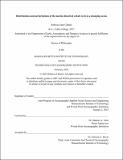Distributions and perturbations of the marine dissolved cobalt cycle in a changing ocean
Author(s)
Chmiel, Rebecca Jane
DownloadThesis PDF (11.93Mb)
Advisor
Saito, Makoto A.
Terms of use
Metadata
Show full item recordAbstract
Cobalt is a necessary nutrient for many marine phytoplankton, but its hybrid-type nature results in small marine inventories that make it one of the scarcest bioactive trace metals in the oceans. This study examines the marine dissolved cobalt cycle in two regions: the Pacific Ocean and Antarctic coastal seas. In the North Pacific, elevated cobalt stoichiometries among phytoplankton were linked to nitrogen, iron and phosphate stress protein biomarkers at the boundaries of oceanographic provinces and upwelling zones, providing insight into the flexibility of cobalt stoichiometry. In both regions, perturbations to the marine cobalt cycle were either predicted or observed; in the equatorial Pacific, the dissolved cobalt inventory was predicted to increase by up to 28% due to the expansion of oxygen minimum zones in a warmer ocean, while in the Antarctic, melting ice shelves have the potential to shift the nutrient regime from iron limitation towards zinc and vitamin B12 limitation, resulting in higher cobalt demand and a lower dissolved cobalt inventory. When the global cobalt cycle was estimated throughout four of Earth’s systems (the lithosphere, biosphere, hydrosphere and the anthroposphere – the human environment), it was determined that the scale of the cobalt flux through the anthroposphere is only one order of magnitude lower than the inventory of the entire hydrosphere (10⁹ mol Co yr⁻¹ and 10¹⁰ mol Co, respectively), revealing a vulnerability to anthropogenic perturbation of the marine cobalt inventory through human mining, use and disposal of cobalt if appropriate pollution abatement, disposal and recycling infrastructure is not established. In light of observed and predicted changes to cobalt biogeochemistry, this research suggests that the marine cobalt cycle is particularly vulnerable to anthropogenic perturbation from both global climate change and pollution due to its low ocean inventory and interconnection to other nutrient biogeochemical cycles.
Date issued
2023-02Department
Massachusetts Institute of Technology. Department of Earth, Atmospheric, and Planetary SciencesPublisher
Massachusetts Institute of Technology